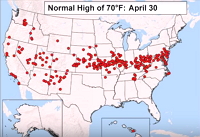Vinniethevan said:
Is there an easy way to follow the weather? I need to stay within a certain zone of comfort especially at night for sleeping and I have done OK by typing in the possible destinations into my weather app on my phone, but is there a map of nighttime temps available? Or future temps?
I'm also inclined to follow weather and here's what I use:
To see a map with a temperature layer of blended colors, do this:
1. Go to
http://weather.weatherbug.com/
2. Click on the map titled "Live Radar"
3. When the map appears, in the lower-left area of the screen you'll see what looks like 3 horizontally oriented diamonds roughly stacked. This symbolizes "layers". Click it and a fly-out menu will appear. Find the option for "Temperature" and click it. In a moment, the map will fill-up with colors. Zoom in and out as you wish, and scroll around by dragging the map with a left-click-and-hold gesture.
If you do this at a particular time of day or night, you'll see nationwide tempertures in nearly real time (I believe the map auto updates about every minute). Generally speaking, I'll check the map each day around 6am and 5pm, which is a fair estimate of coldest and warmest daily temperatures. After you've been checking a few days, you'll get a sense for certain areas of interest.
To see the 10-day forecast (future temps) of a particular city, state, do this:
As before, go to
http://weather.weatherbug.com/
1. Type the city, state in the search box in the upper-right area of the screen.
2. When the screen updates to the current conditions, you'll see 3 links above the large temperature numbers: "Now" (that's the default active link), "Hourly" (to see forecasts by future time of day), and "10 Day". Click that last one and you'll see a 10-day forecast for the area you typed in.
To get a sense for what you might expect from an area beyond the 10-day forecast, do this:
1. Go to
https://www.wunderground.com/ (NOTE: this is a different site from the previous 2 sites above).
2. Type in your city, state in the search bar at the top-center area of the screen and press <Enter> (this is buggy for me and I sometimes have to actually click the city, state that came up in an auto-prediction drop-down menu; that's one of the reasons I rarely use wunderground's site anymore).
3. When the local forecast page appears, you'll see 5 links above the temperature number (and below the city, state). Those links are: Forecast, History, Calendar, Rain/Snow, Health. Click on "History"
On this History screen you'll see a pulldown menu for the Month, another for the Day, and a third one for the Year. If you want to see what this area was like a few months ago, or a few months ahead (but from the previous year), change the Month, Day, and or Year as you wish and click the "View" button. For example, let's change the year to "2016", then the month to "August" (if we change the month first, the screen will complain that you can't navigate forward in history, hence, we change the year first to keep it from complaining).
When you click "View" you'll see information from that day below the date you selected. Below that date, but above the information about that day, you'll see 4 links: Daily, Weekly, Monthly, Custom. For our example, let's pick "Monthly". That will give you a good sense for what happened in August last year. If you want to break it down further, you can choose "Weekly" but I don't find that as useful because 3-4 days of rain, or a wild cold-front pushing down from the North can give an impression other than typical.
By the way, I've walked you through the steps from a desktop computer. If you're using a phone, you may have to adapt these steps a bit.
Happy weather hunting!






